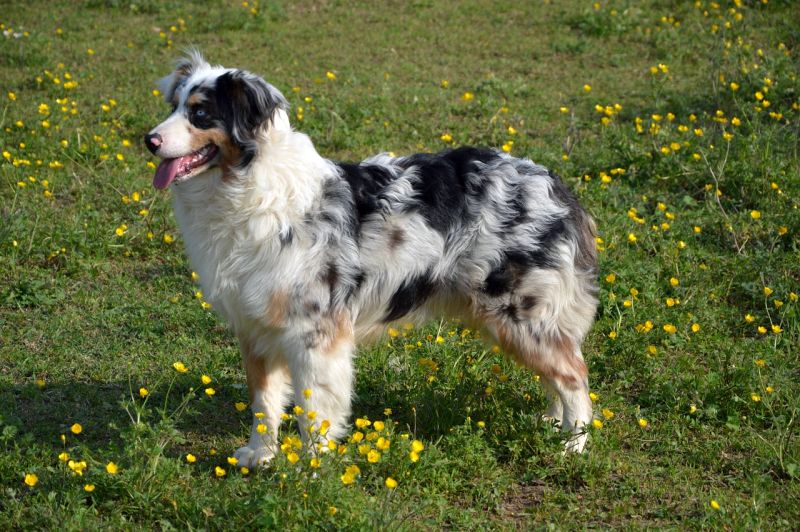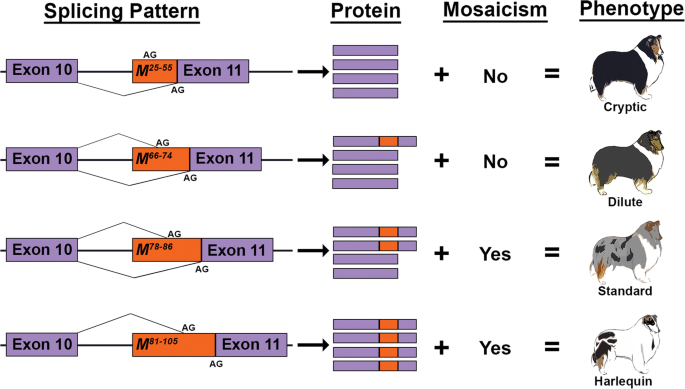Understanding the Merle Gene in Australian Shepherds: A Comprehensive Guide
Table of contents
- Understanding the Merle Gene in Australian Shepherds: A Comprehensive Guide
- What is Merle?
- Diving Deeper into Genetics
- SINE and the Merle Gene Overview
- Understanding SINE’s Dynamics
- SINE Insertion in PMEL17: A Closer Look
- Introducing the PMEL17 Gene
- SINE Integration and Merling Overview
- Exploring the Effects of SINE Length Variation
- Is the Heterozygous Merle Trait Entirely Safe?
- Further Elaboration on the Health Implications of the Merle Gene
- Should We Remove the Merle Gene?
- Conclusion
- Thank you!
Australian Shepherds, with their boundless energy and striking good looks, have captured the hearts of dog lovers worldwide. Additionally, the breed is also growing in popularity in Singapore. Among their diverse coat patterns, the Merle Aussie holds a special place for its unique beauty. But beyond the pretty exterior, the Merle gene carries implications that every Australian Shepherd owner and breeder should be aware of.
As always, article is for knowledge sharing and educational purposes only. If you have suspect that your Merle Aussie is suffering from health issues, please reach out to a Veterinary Professional!
What is Merle?

Merle is not just a colour pattern; it’s a genetic phenomenon that results in a mottled or patchy coat. This mesmerising effect is due to a mutation in the PMEL17 gene, which dilutes the pigment in certain parts of the coat, leading to the distinct appearance of Merle Aussies. However, it’s essential to understand that this mutation affects more than just aesthetics—it has health implications for these beloved canines.
The Science Behind Merle
The PMEL17 gene mutation responsible for the Merle pattern disrupts the normal insertion of pigment into premelanosome, crucial for pigmentation. When two Merle gene carriers are bred, the risks of adverse effects increase, especially in Homozygous Merle pups, where both copies of the gene are affected. These dogs often face significant health challenges.
Above is the gist of this whole article. For those interested in the nitty gritty details, you can check out subsequent sections here!
Implications of the Merle Gene
While Heterozygous Merle (one copy of the gene) Aussies typically lead healthy lives, Homozygous Merle (two copies of the gene) dogs can experience severe health issues, including:
- Deafness
- Ocular conditions
- Skin diseases
- Coat problems
Understanding these risks is crucial for anyone considering breeding Merle Aussies.
We have kept the implications short and sweet for most readers. However, for readers that want to further understand how lack of pigmentation will result in the above said issue, please check out the following section!
Breeding Considerations
Responsible breeding practices are paramount when dealing with the Merle gene. Genetic testing can identify carriers of the Merle gene, including cryptic Merles, who appear non-Merle but can still produce affected offspring.
The Merle gene’s presence isn’t always visually apparent, which poses a significant challenge for breeders. This hidden characteristic, especially in cryptic Merles, makes it deceptively easy to accidentally breed two Merle carriers. Such pairings, often unbeknownst to the breeder, can result in offspring with two copies of the Merle gene.
These Homozygous Merle dogs face a much higher risk of serious health issues, including sensory impairments and developmental problems. This underscores the importance of being exceedingly cautious when selecting dogs for breeding, to avoid unintentionally compounding these genetic risks.
Diving Deeper into Genetics
For those intrigued by the science behind Merle, it involves Short Interspersed Nuclear Elements (SINE) and their insertion into the PMEL17 gene, disrupting normal pigmentation processes. These genetic nuances contribute to the variety of Merle expressions, from cryptic to standard, and influence the associated health risks.

SINE and the Merle Gene Overview
Short Interspersed Nuclear Elements (SINEs) play a critical role in the fascinating world of genetics, particularly when understanding the Merle gene in dogs. At their core, SINEs are sequences of non-coding DNA, meaning they do not directly code for proteins, but they possess the unique ability to move within the genome. This mobility allows SINEs to be inserted into various genes during the DNA transcription process, profoundly affecting gene expression.
In the context of the Merle gene, the insertion of SINEs into the PMEL17 gene disrupts normal pigmentation, leading to the distinctive patterns and health issues associated with Merle coloration in dogs. The mechanisms by which SINE insertion influences the pigmentation process will be discussed in the following sections. Understanding SINEs is the first step toward grasping the complex interplay of genetics that results in the diversity of coat colours and patterns in Merle Australian Shepherds.
Understanding SINE’s Dynamics
The process through which SINEs “move” or get created in a form that can be inserted into DNA is fascinating and crucial for their role in genetic diversity. Here’s a straightforward explanation of this process, known as retrotransposition:
- Transcription: Initially, a SINE sequence is transcribed into RNA. This step is crucial because RNA acts as a messenger carrying the genetic information needed to create a new DNA sequence.
- Reverse Transcription: The RNA transcript of the SINE is then converted back into DNA by an enzyme called reverse transcriptase. This enzyme is key to the process, as it allows the retrotransposition to proceed by creating a DNA version of the RNA sequence.
- Integration: The newly synthesized DNA copy of the SINE is integrated into a new location within the genome. This insertion usually happens at a site with a complementary sequence to the ends of the SINE, facilitated by certain enzymes that help integrate the new DNA into the genome.
This ingenious mechanism enables SINEs to proliferate within the genome, influencing genetic variation and evolution by altering gene expression and function in diverse ways.
SINE Insertion in PMEL17: A Closer Look
The insertion of SINE elements into new genomic locations typically occurs during the cell replication process. Here’s how it unfolds in a practical and engaging way:
- Cell Replication: When a cell divides to produce new cells, its DNA is replicated to ensure that each new cell receives a complete set of genetic information. This process involves unwinding the double-stranded DNA and using each strand as a template to build two new strands.
- Opportunity for SINE Insertion: The cell replication process, while highly accurate, isn’t flawless. Occasional errors or breaks in the DNA strands can occur. It’s during these moments of vulnerability—when the DNA is exposed and more susceptible to change—that SINEs can find an opportunity to insert themselves into new locations within the genome.
- Enzyme Action: The enzyme reverse transcriptase, crucial to SINEs’ ability to jump around the genome, converts the RNA sequence of a SINE into DNA. Then, leveraging the breaks or errors generated during DNA replication, this newly synthesized DNA is integrated into the genome at a new site. This is often facilitated by the cell’s own repair mechanisms, which inadvertently incorporate the SINE DNA into the genome.
Thus, the cell replication process, though aimed at preserving genetic fidelity, inadvertently serves as the prime time for SINE insertion, showcasing the dynamic and somewhat unpredictable nature of genomic evolution.
Introducing the PMEL17 Gene
PMEL17, also known as Premelanosome Protein 17 or SILV, encodes a protein called Pmel17 or SILV protein. This protein plays a crucial role in melanosome biogenesis, which is the process by which pigment-producing cells called melanocytes produce and package melanin pigment into specialized organelles called melanosomes. These melanosomes are then transported and distributed to surrounding cells, such as keratinocytes in the skin or hair cells in the coat, where they impart coloration.
The Pmel17 protein serves several functions in this process:
- Melanosome formation: Pmel17 is involved in the formation of premelanosomes, which are precursor structures to mature melanosomes. It acts as a scaffold protein, helping to organize and arrange melanin molecules within the premelanosome.
- Melanin deposition: Pmel17 helps to deposit melanin pigment within the premelanosomes, contributing to the accumulation of pigment within these organelles.
- Melanosome maturation: Pmel17 plays a role in the maturation of premelanosomes into mature melanosomes, which involves the conversion of precursor molecules into melanin pigment.
SINE Integration and Merling Overview
Understanding how SINE insertion impacts the PMEL17 gene and consequently leads to the merling effect involves looking at the disruption of the normal processes within melanocytes, the cells responsible for producing melanin pigment. The SINE insertion into the PMEL17 gene affects the protein’s ability to function correctly in several key ways.
Firstly, it interferes with the formation of premelanosomes by disrupting the scaffolding role of the Pmel17 protein, meaning that the initial stages of melanosome development are compromised. This disruption leads to irregularities in melanin deposition, as the altered structure or functionality of premelanosomes cannot adequately support the uniform accumulation of pigment.
Note: Fibrillar matrix within premelanosomes serves as a scaffold for the deposition of melanin. Without these, melanin cannot be effectively stored, resulting in dilution of the coloration (Merling)
Lastly, the maturation of these premelanosomes into fully functional melanosomes is affected, which impacts the final distribution of melanin within the coat. In essence, the SINE insertion causes a cascade of disruptions in melanin packaging and distribution, leading to the diluted coat color and unique patterning seen in Merle dogs. This genetic anomaly creates variations in pigment intensity and distribution, hence the distinctive appearance of animals with the merling effect.
Exploring the Effects of SINE Length Variation
A crucial factor determining the extent of disruption to the PMEL17 gene, and consequently the variation in the merling effect, is the length of the SINE insertion. Not all SINE insertions are created equal; they can vary significantly in length. This variance affects how much the normal processes within melanocytes are interrupted. Shorter insertions may cause minimal disruptions, potentially leading to subtle or cryptic merling patterns that are barely noticeable. On the other hand, longer insertions can drastically interfere with the PMEL17 gene’s function, leading to more pronounced merling effects, such as the striking contrasts seen in the Harlequin pattern.

Although the Merle gene is key in creating unique coat patterns in dogs, it’s influenced by a complex interplay with other genes. These interactions can enhance or mask the merling effect, leading to a wide range of unique and unpredictable appearances, highlighting the complexity and beauty of canine genetics.
- Cryptic Merling: The cryptic merling category is characterized by very short SINE insertions, which cause minimal disruption to the PMEL17 gene. Animals within this category often exhibit merling patterns that are so subtle they may not be immediately noticeable. This can include small patches of diluted pigment or slight variations in color that only become apparent under specific lighting conditions or as the animal matures.
- Dilute Merling: Animals classified under the dilute merling category have slightly longer SINE insertions than those with cryptic merling. These insertions moderately interfere with the PMEL17 gene, leading to a more noticeable dilution of pigment across the coat. The dilute merling effect produces a soft, muted appearance in the coat colors, with the patterns being more discernible than in cryptic merling but still lacking the stark contrasts of more pronounced merling patterns.
- Standard Merling: The standard merling category is marked by medium-length SINE insertions, which significantly disrupt the normal functioning of the PMEL17 gene. This results in the classic merle pattern of irregularly shaped patches of diluted pigment interspersed with areas of full pigment. Standard merling is what most people envision when they think of a merle coat pattern, offering a balance between dilution and the natural base color of the animal’s coat.
- Harlequin Merling: Harlequin merling involves the longest SINE insertions, leading to the most dramatic disruption of the PMEL17 gene. This causes a striking contrast in the coat, with large patches of full pigment and areas of almost completely diluted pigment, creating a pattern reminiscent of a harlequin’s costume. The harlequin pattern is the most distinct among the merling categories, with bold, contrasting colors that make it highly sought after for its unique and eye-catching appearance.
Each category reflects the impact of the SINE insertion length on the merling effect, showcasing the range of patterns that can emerge from this intriguing genetic phenomenon.
Therefore, understanding the specific length of the SINE insertion in an individual animal is key to predicting the degree of merling effect observed in their coat. This variation underscores the complexity of genetic factors influencing coat color and patterns, highlighting the intersection of genetics, biology, and physical appearance in a way that is both fascinating and practical for breeders, geneticists, and pet enthusiasts alike.
Is the Heterozygous Merle Trait Entirely Safe?
The short answer is no – heterozygous merle animals, carrying one copy of the merle gene, are indeed more at risk for certain health complications compared to non-merle counterparts. These risks primarily revolve around auditory and ophthalmic issues, with a notable incidence of hearing impairment and eye abnormalities. Additionally, there are significant coat and skin-related issues caused by the Merle gene.
See the next section for potential issues that may be caused by the Merle gene!
However, it’s crucial to remember that while these risks exist, heterozygous merle animals often lead generally healthy lives. With proper care, regular health check-ups, and attention to their specific needs, these animals can enjoy the same quality of life as non-merle animals. The key is awareness and proactive management of their health by owners and veterinarians alike.
Further Elaboration on the Health Implications of the Merle Gene
The Merle gene, characterized by a reduction in pigmentation, has several health implications for Australian Shepherds, particularly in Homozygous Merle (double Merle) dogs. Here’s a deeper look into how the lack of pigmentation contributes to each health issue:
- Deafness: The reduction in pigmentation caused by the Merle gene can affect the inner ear’s development, leading to congenital deafness. This is because the cells responsible for hearing require a certain level of pigmentation to function correctly. In double Merle dogs, where pigmentation is significantly reduced, these cells may not develop as they should, resulting in impaired hearing or total deafness.
- Ocular Conditions: Eyesight problems in Merle Australian Shepherds often stem from the lack of pigmentation in critical parts of the eye. The pigmentation is crucial for the normal development and function of the eye, and its absence can lead to various ocular conditions, including microphthalmia (abnormally small eyes), irregularly shaped pupils, and even blindness. These issues arise because pigmentation plays a key role in the eye’s internal structure formation.
- Skin Diseases: Reduced pigmentation in the skin can leave Merle Australian Shepherds more susceptible to skin diseases. Pigment serves as a natural barrier and protector against ultraviolet radiation and other environmental hazards. Without sufficient pigmentation, the skin becomes vulnerable to a range of issues, including sunburn, skin cancer, and other dermatological problems exacerbated by increased sun exposure.
- Coat Problems: The lack of pigmentation does not just affect the skin; it also impacts the quality and health of the dog’s coat. In Merle breeds, the uneven distribution of pigment can lead to a thinner coat, which reduces the natural protection against external elements. This can make Merle Australian Shepherds more prone to suffer from various coat problems, including increased risk of infections, infestations, and conditions like Alopecia, where hair loss occurs.
Understanding the above implications, it becomes clear that breeding practices must be approached with utmost care to avoid the health issues associated with the Merle gene. Responsible breeding and proper genetic testing are essential to ensure the well-being of these beautiful and beloved canines.
Should We Remove the Merle Gene?
While the health challenges linked to the Homozygous Merle gene are concerning, eradicating the gene entirely could have unintended consequences, such as reducing genetic diversity and potentially amplifying other recessive diseases.
There is no one-size-fits-all solution or “silver bullet” when it comes to managing the complexities of the merle gene within Australian Shepherds. Achieving the ideal balance requires an active, ongoing effort from breeders, veterinarians, and the wider community. The goal is to enhance the breed’s health and quality of life while preserving the unique beauty and diversity that the merle gene contributes. This endeavor involves responsible breeding practices, informed decision-making, and continuous research into genetic health. By working collaboratively, we can ensure the Australian Shepherd breed not only maintains its distinctive appearance but also moves forward in health and vitality.
The key lies in informed breeding practices and educating potential owners about the responsibilities of caring for a Merle Aussie.
Conclusion
The Merle gene in Australian Shepherds presents a double-edged sword, offering stunning visual diversity at the potential cost of health issues. By prioritizing responsible breeding practices, genetic testing, and education, we can ensure that the beauty of the Merle Aussie is preserved without compromising the health and wellbeing of these cherished dogs. Whether you’re a seasoned breeder or a first-time Aussie owner, understanding the complexities of the Merle gene is a step towards ensuring a brighter future for these remarkable companions.
Thank you!
Thank you to all our readers, especially those who have Merle Australian Shepherds and can personally relate to the content discussed. Your insights, experiences, and shared stories enrich the conversation and contribute significantly to a broader understanding of the complexities involved with the Merle gene. Your active participation in responsible breeding and care practices plays a pivotal role in shaping the future health and wellbeing of these magnificent dogs.

For readers who may not directly relate but have taken the time to engage with this information, your constructive criticism is invaluable. It challenges us to look at the issue from different perspectives and encourages a more comprehensive and inclusive dialogue. Together, through open exchange and thoughtful critique, we can collectively contribute to the betterment of the Australian Shepherd breed.
Thanks, Peace and Love!
Shafik Walakaka